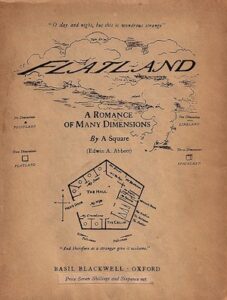This post was originally published in “Download the Universe,” a multi-author blog about science ebooks edited by Carl Zimmer.
Flatland. By Edwin A. Abbott. Originally published in 1884.
Guest reviewed by Jaime Green
January 17, 2013
Google Play, Project Gutenberg
 When I was about twelve years old, I saw the shadow of a four-dimensional cube. It was in a special exhibit at the New York Hall of Science on geometry and topology, the math of surfaces and shapes. And for some reason, it’s stuck with me. A three-dimensional model built of angles and lines, square and trapezoids, like a metastasized cube. It was hung in mid-air, just above my tween eye level.
When I was about twelve years old, I saw the shadow of a four-dimensional cube. It was in a special exhibit at the New York Hall of Science on geometry and topology, the math of surfaces and shapes. And for some reason, it’s stuck with me. A three-dimensional model built of angles and lines, square and trapezoids, like a metastasized cube. It was hung in mid-air, just above my tween eye level.
I can’t quite picture the three-dimensional shadow now. So many years have passed. It’s also the sort of thing that hovers just beyond your understanding, so it’s fitting that the memory flits out of reach, too. Much of trying to understand advanced math can be like that. You understand the analogy, or you can read the equation, but you can’t really picture the concept. You know it’s there. Maybe if you sit very still, maybe if you hold your breath, something will flash into your mind. Imagine a four-dimensional sphere. Just try.
The best pleasures of Edwin A. Abbott’s classic book, Flatland, are the moments in which Abbott draws you a little closer to that flash of insight, impossible as, for a layperson, it may be. Through analogy and explanation, Abbott makes you feel like you are a hair’s breadth away from understanding, from being able to see in four dimensions. It’s a book about math and yet, even despite its short length, it’s much more.
Written in 1884 by an English schoolteacher and theologan, Flatland is by pretty equal division half satire of Victorian society and half philosophical exploration of geometric dimensions. It was not a huge success in its initial publication, but in the years since it has come to be a beloved classic, the kind of book–if my experience is any indication–math teachers recommend to their eager students. Other authors have written imitations and sequels – Sphereland, The Plainiverse, and Flatterland, among others – and there have been several filmed adaptations. Now it is available a free ebook, with Abbott’s lovely schematic illustrations intact.
The narrator of Flatland is a square, who lives in an eponymous two-dimensional world with other geometric shapes. The first part of the book, called “The World,” is taken up by a detailed evocation of the social structure of Flatland. A shape-person’s number of sides and symmetry corresponds with his advancement. Thieves and vagabonds are isosceles triangles. Lawyers and doctors are squares. The aristocracy is made of many-sided polygons, and at the top of the social hierarchy, the priests are all circles.
Well, those are the men. All women in Flatland are lines. As they have no insides, they have no capacity for analytical thought or, it seems, any memory or long-term thinking at all. Their pointed ends are dangerous and nearly invisible, and so women must announce their presence by a gentle waggling to make themselves visible when seen end-on, or by the constant soft utterance of a “peace-cry.”
As I read, I couldn’t decide whether this was satire or some really hardcore misogyny and social conservatism. Across a gulf of more than a century, I had trouble divining Abbott’s authorial intent through his writing. The Internet tells me Abbott was a social reformer, and that the square’s endorsement of Flatland’s absurdly rigid social strictures is satire. And yet the square, our narrator and guide, is a sensitive, inquisitive, and responsible shape. Without the cues of a silly or maleficent character endorsing the satire, I was never sure where we stood. I couldn’t tell if the social world of Flatland was absurd because Abbott meant it to be so, or because he wrote this book over a hundred years ago.
Abbott’s catalogue of details about Flatland’s society and history felt dry and weakly imagined. The square goes into great depth about the impact of irregularity on Flatland’s living shapes, the methods of recognition (necessary since any shape seen edge-on appears as a line), the detailed history of the Color Rebellion. I was left longing for the explanations I really wanted, the good sci-fi realities of the world. How do shapes move and manipulate objects if they don’t have hands? How do squares and straight lines reproduce? How could 120,000 triangles gather around a speaker? Since they only see in the flat plane of their world, shouldn’t it be impossible for them to see around or over someone standing in front of them? Abbott asks the reader to brush away all curiosity about these logical concerns. That’s a tall order for a demanding reader used to more recent science fiction and science writing.
But then the good stuff starts. In Part Two of Flatland, called “Other Worlds,” a sphere travels from Spaceland (our three-dimensional world) into Flatland. It offers the square a vision of – and a visit to – worlds of other numbers of dimensions. First the square dreams – it’s implied that the sphere somehow conjures this vision – of Lineland, where one-dimensional beings shimmy next to each other in their straight line world, and can’t begin to comprehend a second dimension. Then the sphere brings the square into Spaceland, pretty much blowing his mind. The square returns home grasping fleeting memories of cubes, and struggling with the impossible mission of explaining the brave new three-dimensional world to his flat comrades.
The real joys of Flatland come from accompanying the square into 3-D space. By extrapolation of his struggle to understand, we can edge up to imagining geometry in four dimensions. It’s mental acrobatics akin to trying to lick your elbow: striving for a thing that’s there but beyond reach. I found myself setting down the ancient Kindle on which I read this book and straining to picture geometry in four dimensions. Square a line: you get a square. Square a square: you get a cube. Square that again. I strain and strain and can almost get there. The sphere can see our square’s insides from outside Flatland. Could a four-dimensional being see mine?
As a philosophical and mathematical exploration, the second half of Flatland is as effective and compelling a piece of writing as it ever was. Abbott’s target for the very serious satire of the first half, on the other hand, has faded into history, and we’re not the readers it was written for. So maybe skip ahead to Part Two. You may not come away with a clear vision of a four-dimensional cube, but you’ll get tantalizingly close. And that new way of thinking about the very space you move through stays with you more than a clear and easy answer ever would.
 Jaime Green is a graduate student in Columbia’s MFA writing program. Her work has appeared in The Awl, Spezzatino, The Hairpin, and Parabasis. She is writing a book about the possibility of life in the universe.
Jaime Green is a graduate student in Columbia’s MFA writing program. Her work has appeared in The Awl, Spezzatino, The Hairpin, and Parabasis. She is writing a book about the possibility of life in the universe.
GeorgeP says:
Nice review. I loved the book and I understand some of the reservations (on the mathematically inconsistent parts). But the parts on the author’s intentions and whether it’s parody or misogyny I found them disappointing. So, should subtlety be abandoned or toned down in works of literature (and let’s not forget this is a review of a literature book, it’s not a scientific article) to remove doubts? Books would be boring like this. Does one have to know precisely the author’s background, personality and society to appreciate a book? And anyway, has satire an expiry date and one century is too much of a gap? (Anyway, that’s why we like to learn basics of history, to be able to detect nuances, to understand the culture of other societies and indirectly more of ourselves). The answers to the above questions seem to be yes, implied in the review, and they are strange points to make, especially coming from a reviewer with background in creative writing and not a scientist. Actually, the satire was not even that subtle (even without a ridiculous character endorsing it, as mentioned… That would be a crude device I think).
Hope this comment didn’t come that strongly by the way, I admit this is a recurrent conversation I have with my friends when discussing books, and my bias is always on more doubt and subtlety.